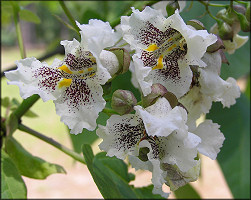I now have 127 trees on the list, though I did add in the native palms, which aren't much for shade. I also made some notes based on the University of Florida's Horticulture Deptartment's Tree Fact sheets.
I just had the strongest sense of deja vu, while writing that sentence...
Anyway, as UF is the state's main agricultural extension university the horticulture department discusses many facets of arboriculture in great detail, and goes so far as to make recommendations about trees that should be planted more. Among the trees so designated are the American Hornbeam and Redbay, which I recommended in the comments to the earlier post. Golly gee, it's neat when experts agree with you. (They also like the Hophornbeam, one of my all-time favorite trees.)
However, I'll save the list of recommended trees for another day. Today I wanted to suggest trees that should be planted instead of the hideous Stinking Pear Tree, or Bradford Pear as it is sometimes known (technically the Callery Pear). Aside from their floral stench (it's been compared to rotting meat, and more poetically to "dead fish in a dishwasher" (thank you, Port Tampa). But it is rather pretty.
 To bad it's not a good tree, according to UF: "...as 'Bradford' and some of the other cultivars approach 20 years old, they begin to fall apart in ice and wind storms due to inferior tight branch structure." (UF, surprisingly, does not mention the odor of Bradford Pears, though the Clemson University factsheet on the tree does.) Also, the things are native to China, and the last thing we need right now is more Chinese imports.
To bad it's not a good tree, according to UF: "...as 'Bradford' and some of the other cultivars approach 20 years old, they begin to fall apart in ice and wind storms due to inferior tight branch structure." (UF, surprisingly, does not mention the odor of Bradford Pears, though the Clemson University factsheet on the tree does.) Also, the things are native to China, and the last thing we need right now is more Chinese imports.Forthwith, a selection of twelve flowering trees native to Florida! These are not my pictures; click the photo for a link to the site where I found it. I'd love to use my own pictures but all these trees could stand to be planted more--if they were, I'd have taken my own photos.

1. Downy Serviceberry (Amelanchier arborea)

2. Tree Sparkleberry (Vaccinium arboreum)

3. Flatwoods Plum (Prunus umbellata)
4. Southern Crabapple (Malus angustifolia)

5. Eastern Redbud (Cercis canadensis)

6. Southern Catalpa (Catalpa bignonioides)

7. Red Buckeye (Aesculus pavia)
8. Sourwood (Oxydendrum arboreum)

9. Carolina Silverbell (Halesia carolina)

10. American Smoketree (Cotinus obovatus)

11. Fringetree (Chionanthus virginicus)

12. Rusty Blackhaw (Viburnum rufidulum)
Now I'll admit these trees may not be as showy as the Chinese Stinking Pear, but they are native, and most of them have wonderful fragrances. Many of them have showy fruits that last into the autumn and winter, an added bonus.
2 comments:
The day we moved into our last house a neighbor came by to say "hi," and tell us the builder had put our door knocker on upside down and planted the "wrong" tree in our front yard. (That was all I needed to keep the door knocker the way it was.) My Eastern Redbud struggled a bit through 3 years of drought and a Brood X cicada hatch, but sticking by its relatively slow growth paid off every time we had a high wind. At best, the "right" Bradord Pears lost a a limb or two. At worst, they split down the middle. I must admit to guilty admiration of their few short weeks of stinky bloom, en masse they are a pale Seurat painting. But, a trip up 98 to the panhandle showed me that there must have been a time when redbud was a very popular choice for Florida yards. It was in full bloom last weekend and I feel sorry for those who missed it.
Good lord that is a huge redbud. There is one in our back yard, though not for long since I'm going to have to be moving. They are planting some around the roads over here at Clemson. And don't forget the lovely heart shaped foliage of the redbud too.
A friend has a file that has all of the trees on campus, the number and percentage. I'll try to get a copy of that for you if you want it.
Clemson has a lot of white oaks, but I don't have much against them. I dislike the small leaved oaks. My parents had a Post Oak beside our house, and to me that was a real oak tree. Some of the leaves were 15+ inches long. When they fell it would blanket the ground in 8 inches of crinkly, leathery, legal pad sized leaves. And drought never touched it.
And while looking up trees I found out that Clemson is a 4 on the squirrel meter: known for their size, number, and ballsiness. I'd say they got that right. And I also found a PDF of the common organisms of the Clemson Campus.
Post a Comment